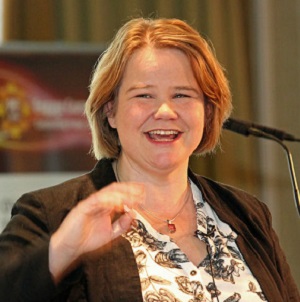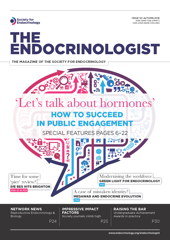
The NCCPE award ceremony, credit: NCCPE
Imagine going to a party and telling someone about your work as an endocrinologist. Where does the conversation take you? What captures people’s interest? How do people make sense of what you do, and relate it to their own experiences, or the experiences of those they love?
‘Public engagement’ is an umbrella term covering the multifarious ways that researchers engage with people outside their institution. At the heart of public engagement we find people coming together and identifying common ground. Often enjoyable, sometimes challenging, engagement opens up new connections and can enrich your work. So surely it should be easy!
MOTIVATIONS AND CHALLENGES
Over the past decade, researchers have faced increasing pressure to engage with the public. Motivations are many: wanting to develop impact, inspiring young people, improving quality of research, encouraging behavioural change, developing new skills etc. However, the importance of public engagement is not restricted to researchers. Community engagement and patient and public involvement each have increasingly important roles to play for clinicians. Whilst a recent study suggests 82% of researchers have engaged with the public over the last 12 months,1 there are challenges, including the time available and the pressure of other academic pursuits. The academic culture is not always conducive to engagement.
The funders of research are well aware of these challenges, and increasingly look to support researchers to engage. The Concordat for Engaging the Public with Research2 sets out funder expectations as to how researchers should be supported. It highlights the importance of reward and recognition, training and development, learning and support, and providing opportunities for researchers to ‘dip their toe’ in the water – or to take part in more ambitious programmes. At the core of the Concordat is the expectation that the universities, clinical settings or research institutes where researchers work will commit to the importance of engagement. Without that strategic commitment, it is hard for engagement to thrive.
SUCCESS STORIES
So what does excellence in engagement look like? The finalists of our National Engage Competition3 provide a snapshot of the diverse approaches:
- Conker Tree Science – school children worked with researchers to investigate an invasive species.
- Bright Club – researchers did stand-up comedy in front of a paying audience.
- Everyday Heroes of Postman’s Park – an interactive app enabled people to investigate the stories of individuals commemorated in a local memorial.
- Dance for Parkinson’s – research findings informed development of dance sessions for those with Parkinson’s.
- What If? – school children worked with researchers to explore where their questions could take them.
- Caer Heritage Project – local people and researchers worked together to investigate a local hill fort.
'Public engagement, when done well, can have an impact on you, your research and practice, and those you engage with. It can be challenging, but it can also be enormously rewarding'
These projects illustrate the hallmarks of great engagement, namely:
- Mutual benefit: for the people who participate, and for you and your research.
- A clear purpose: within one or more of these overarching themes:
- Listening – whether through consultation or advisory groups, engagement can provide a wealth of insights and new thinking
- Inspiring – finding accessible and engaging ways to bring your specialist knowledge to life
- Collaborating – really respecting the expertise and experience of (for example) a patient group, and finding constructive ways to work together to get things done.
- Thinking carefully about the ‘who’: it’s easy to talk about ‘the general public’, but great engagement is usually animated by a careful approach to considering who to involve and their motivations and expertise.
- Effective use of evaluation: to ensure you plan effectively, tailor your activities to the interests of those you want to engage, and assess how you have delivered against your purpose.
LOOKING FOR HELP?
A lot of advice and support is available to help develop your engagement work, or a culture that supports it. The National Co-ordinating Centre for Public Engagement (NCCPE) works nationally, offering consultancy, training, online resources and events, including our annual Engage Conference in Bristol (29–30 November 2016).
Learned societies, such as the Society for Endocrinology, provide funding, support and opportunities. Your own institution may also have a public engagement co-ordinator or team. For those of you interested in patient and public involvement, Involve provides excellent advice.
Public engagement, when done well, can have an impact on you, your research and practice, and those you engage with. It can be challenging, but it can also be enormously rewarding. It could be as easy as just starting a conversation about your work. Why not give it a go – who knows where it might lead?
Sophie Duncan
Deputy Director, National Co-ordinating Centre for Public Engagement
The NCCPE supports universities and research institutes in their engagement with the public. It is funded by Research Councils UK, the Higher Education Funding Councils and the Wellcome Trust, and hosted by the University of the West of England and the University of Bristol.







